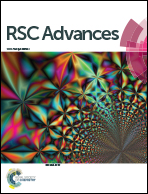Screening PEGylated polyethylenimine derivatives for safe and efficient delivery of gene materials
Abstract
Gene-based therapy has broad and important clinical applications, and the non-viral vector delivery of exogenous nucleic acids is commonly used for gene therapy. Among the numerous gene delivery vectors, the cationic polymer vectors are considered to be the most promising materials for gene delivery and gene therapy. In this study, we chemically modified a novel cross-linked PEI derivative PEI–Et through PEGylation, as PEGylation can reduce the cytotoxicity of PEI–Et by shielding the excess positive surface charge of PEI–Et. To screen out an optimal molar ratio of PEI–Et to PEG for efficient delivery of gene materials, we first synthesized three kinds of PEG–Et cationic polymers with different molar ratios (1 : 1, 2 : 1, 1 : 2) of PEI–Et to PEG, then we prepared and characterized the PEG–Et/DNA complexes and PEG–Et/siRNA complexes, and finally we tested the cytotoxicity and transfection efficiency of the PEG–Et/DNA complexes as well as the gene silencing efficiency of the PEG–Et/siRNA complexes. The results suggest that the gene vector PEG–Et 1 : 1 (with a 1 : 1 molar ratio of PEI–Et to PEG) was the best among the three types of PEG–Et (PEG–Et 1 : 1, PEG–Et 2 : 1, and PEG–Et 1 : 2) for condensing DNA and siRNA into nanoparticles, as it has significant lower cytotoxicity, higher gene transfection and siRNA silencing efficiency.


 Please wait while we load your content...
Please wait while we load your content...